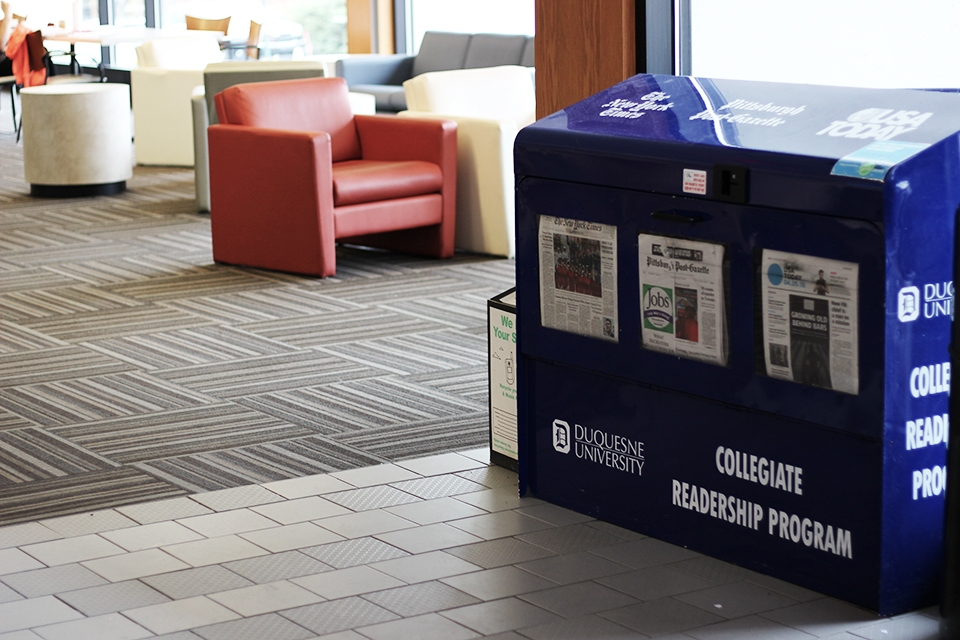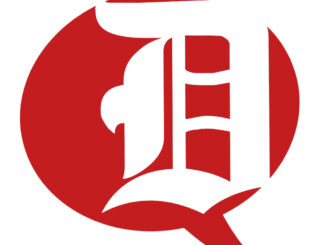
One of several newspaper stands on campus. The stands, sponsored by SGA, offer free national papers to students at DU.

One of several newspaper stands on campus. The stands, sponsored by SGA, offer free national papers to students at DU.
Ollie Gratzinger | Opinions Editor
04/26/18
According to the Associated Press, there were 276,000 more journalists in the country 20 years ago than the 150,000 that work in the U.S. today.
In the past two decades, journalism as a profession has decreased by 65 percent. With the proliferation of online news platforms and the sharp decline in the newspaper industry, printed publications have experienced decreases in revenue and readership. Now, newspapers across the country face another threat: tariffs.
NBC News reported that “recently imposed tariffs on Canadian newsprint” are hiking up costs of publication for smaller or underfunded papers in the U.S. The article goes on to explain that the tariffs came in response to “a complaint to the U.S. Department of Commerce from a hedge fund-owned paper producer in Washington state, which argues that Canadian competitors are taking advantage of government subsidies to sell their product at unfairly low prices.”
However, there is concern regarding the notion that it may not be Canadian big businesses that feel the heat of the tariffs, which are as high as 10 percent. Newspapers around the U.S. have begun discussing what steps must be taken in order to continue operating despite the increased cost of production. Several Duquesne graduates have broken into the field of journalism, but for them, tariffs promise uncertainty.
“We’re having a meeting later this week where we’re going to be talking about … having less pages and possibly having subscribers pay higher prices,” Sean Ray, ex-Duke A&E editor and current reporter at The Titusville Herald, said. “If we do have less pages, one thing we’re going to have to do is cram a lot more articles on a page. This means articles are going to have to be short. While people will still have the same amount of news, it won’t be nearly as extensive coverage.”
Ray also stressed the importance of soft news — news that is entertaining rather than hard-hitting — and the impact that tariffs could have on this type of work, which many readers enjoy.
“We aren’t going to have a chance to do fun news stuff or small town community events that aren’t as impactful,” Ray said. “We did a weather story about how long the warm weather was going to be around. A lot of people like that kind of stuff, but we won’t be able to justify putting out the space for that.”
In an effort to save space, discussions have begun regarding which corners may have to be cut.
“Some of the things we discussed included having less color pages, printing one less day, cutting out comics or puzzles or other fun features, condensing or combining pages and even asking some of our contributors to put less in their articles,” Ray said.
The alternative to fewer pages or higher fees is monetary repercussions, which could prove dire.
Brandon Addeo worked with The Duke as News Editor for a year until his graduation in May 2017. Now, he works as a reporter with The Sandusky Register — an Ohio newspaper that could face a heavy financial blow.
“If the tariffs go through, it would cost our paper approximately an added $30,000 annually,” Addeo said.
One possible answer to the questions tariffs pose is the further digitization of newspapers. Steve Mellon, adjunct journalism professor at Duquesne and reporter at the Pittsburgh Post-Gazette, believes that this solution could have both a positive impact and negative repercussions.
“The future in news is digital,” Mellon said. “As our print base shrinks, our digital audience continually grows. That, to me, is the upside: a growing audience, an availability of storytelling tools that we’ve never had before and that our audience is not limited geographically.”
However, many of the area’s elderly readers who have relied on printed copies for years struggle with accessing online content.
“In [Titusville], a lot more of our readers are older,” Ray added. “We’ve gotten calls where they’re asking where articles are online, or they don’t understand e-editions.”
Mellon echoed these sentiments, but he believes the transition to digital is, in fact, easily done.
“[Pittsburgh has] an older population and an older readership for print, and that’s the only way they access our content and our news,” Mellon said. “The trick is going to be transitioning from print to digital in a way where you don’t leave people behind, but you bring them with you.”
The tariffs aren’t set in stone yet. There is still the chance that, come summertime, a decision will be reached that renders them inert. But nonetheless, journalists are concerned.
“If [the tariffs] were to stay in place, I feel like they could kill a lot of small-town papers and very much limit coverage,” Ray said. “The thing people have to remember is that right now, the tariffs are in a trial stage. It won’t be until the summer that it’s decided whether or not they’ll become permanent. I’m really hoping they don’t.”
Many fear that if the tariffs do stick around, it will be the end of an era in terms of print journalism. Mellon disagrees.
“I’ve been around long enough to hear, ‘This is the end of this or that,’ and have it turn out to be not the case,” Mellon said. “Whatever it is that’s supposed to die springs back to life. Life is unpredictable that way.”
Nevertheless, the face of journalism is changing. That much, Mellon says, is undeniable.
“I do think that it’s another sign that we are headed in a digital direction,” he said. “That ship is not going to turn around.”




